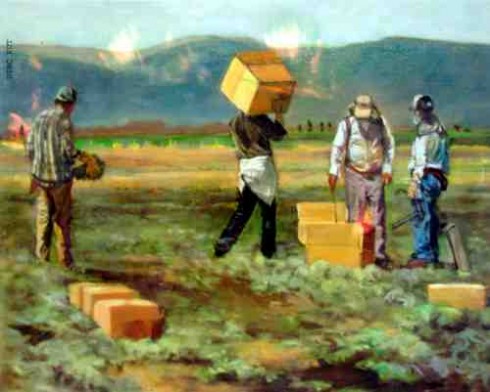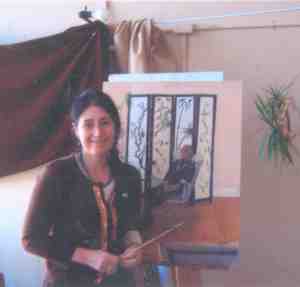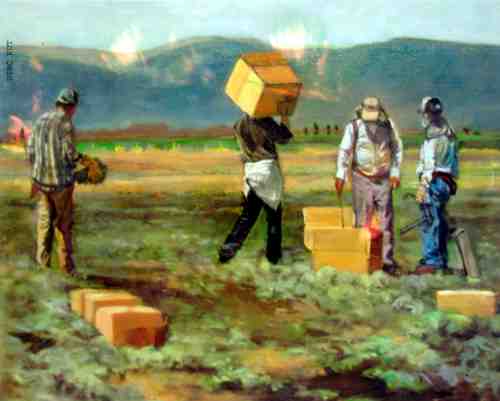Article by Marcia Darnell
Local Artist – February 2007 – Colorado Central Magazine
FARMWORKERS ARE GENERALLY hidden from the American consciousness. Those who labor to provide our food are invisible, except when held up as objects of pity. Artist Annette Troncoso sees them differently. Her paintings honor the farmworkers, imbuing them with pride and dignity.
When I arrived at Troncoso’s studio for an interview, she was working on a new painting. The models, Marlin Peterson, and Troncoso’s stepdaughter, Christine Bosa, had stopped by to visit and Troncoso inveigled them into posing.
“I really prefer to work from live models,” she says, “but sometimes I can’t, so I use my own references — drawings or photographs.”
Originally from L.A., she came to the San Luis Valley in the early ’80s. “I had lived in Colorado before,” she says. “I went to school in Gunnison for one year, then to Adams State and I wanted to return.”
She and her then husband settled in the Valley to build their own house and live an outdoors-centered lifestyle. The marriage ended, however, and the house was sold. Troncoso traveled, and lived in other places, and studied art in New York.
“But I always come back to the beauty of this place,” she says, “and the older I get the more I like having a home base.”

Now in her 40s, she lives near Alamosa. Her studio is on the second floor of the Masonic Building in downtown Alamosa.
“I love this work space,” she says. “One reason I’m able to get so many models is because of this location. Lots of people have no transportation, so it’s easy for me to pick them up and drop them off.”
She says the traffic noise of Main Street isn’t a distraction, but a reassurance.
“It can get lonely in a studio,” she says. “I like the life of a city, the reminder that there’s life outside the painting.”
To combat isolation outside the studio, she surrounds herself with friends and family, maintaining close relationships on both coasts.
Troncoso also teaches, and is currently instructing two students from Alamosa High School.
“It’s wonderful to me,” she says. “It helps to have young people in your studio. You always receive more than you give.”
She was a special education teacher before quitting to paint full time about a year ago. Since then she’s received lucrative commissions from the San Luis Valley Regional Medical Center and La Puente, the Valley’s homeless shelter. Her work can also be seen at Firedworks gallery in Alamosa and behind the checkout desk at Southern Peaks Public Library. Valley Wide Health Services proudly displays her work in its administrative offices.
Troncoso paints landscapes and portraits, but her specialty is farmworkers.
“I was a young person in L.A. during the time of Cesar Chavez and the boycott,” she says. “I had a lot of exposure to that and those images stayed with me.”

THAT WORK is especially meaningful in the agricultural San Luis Valley. “Here in the Valley there are still people working the land,” she says. “They’re very hard-working people, supplying our food.”
Her collection “Agriculture at the Turn of the Century,” is very powerful, depicting farmworkers in the year 2000.
“With all our technology, we still have these people working in the fields,” Troncoso says.
Her mural at La Puente was drawn from farmworkers who live at the shelter.
“Annie has been a soulful supporter of La Puente for years,” says La Puente Director Lance Cheslock. “She has a heart for the migrant farmworkers and always has. She has donated paintings for our charity auction, but this year she put together a fabulous mural that portrayed some of the guests who were at the shelter in the context of their field work.”
Cheslock says the mural inspires the shelter’s guests.
“When we honor and uplift in our art these people we serve it gives them a lot of dignity and it lifts their spirits to see themselves honored. Representing that part of our society in art is unique, a poignant expression of love.”
“I try to honor the farmworkers,” Troncoso says humbly.
She says she enjoys being outdoors to work on the paintings. “I like integrating people with the landscape,” she says.
She also likes the seasonal aspect of the work, painting farmworkers during planting and harvest, and working on landscapes and portraits year round.
“Illustrations, paintings, portraits, I want to be good at everything,” she says. “I’m hoping all these experiences will lead to something. If it doesn’t, at least I’m working the way I want.
“Artists are life-long learners,” she says. “Art is not instant gratification.”
Her painting “Rebecca” is a portrait of a La Puente volunteer from Europe. The model posed in the studio, holding myrrh in her hand, but the backdrop is natural, featuring a crabapple tree in bloom. That “tree” was a branch that fell off in Troncoso’s yard. She hauled it into the studio and put it in water. When she returned from a trip, the branch was in full bloom.
“We brought nature into the studio.”

SHE LIKES PAINTING young people and children. A recent ad for volunteer subjects brought her a mother and 9-year-old twin daughters to pose. She thought she had enough girls for the series she was producing, but the trio looked just right the moment they stepped into the studio.
“I did so many things throughout my career,” she says, “but now I just let things happen.”
Troncoso is also painting the elderly. Seeking practice, she advertised at the Alamosa Senior Center, promising a free portrait to those who posed for her. The result was not just new work, but new friends as well.
“They’ve been wonderful,” she says. “They are true friends.”
Many of her “volunteers” are now paid models.
She says being an artist has altered her perceptions, and she sees color in everything, everywhere. She notices the colors of leaves in her yard while drinking coffee in the morning, for example.
Troncoso is working on expanding her business as she builds her repertoire. She’s planning to expand into other galleries and is working on a website to show her work to the world.
“I’ve never been content in my life,” she says. “I always want more. More models, more light, more experiences, more friends. But I’m very happy to be an artist.
“I’ve tried quitting many times, but I’m compelled to do it.”
Marcia Darnell lives, writes, and hangs out in artists’ studios in the San Luis Valley.

